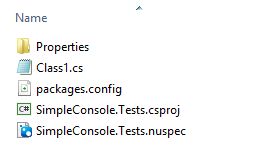Build phase
After cloning the repository, AppVeyor runs MSBuild to build project sources and package artifacts.
The following command is used:
msbuild <project> /logger:"C:\Program Files\AppVeyor\BuildAgent\Appveyor.MSBuildLogger.dll"
Custom logger is required to push MSBuild warning and errors in real-time to build console. You may use this logger in your own build scripts.
<project> is a Visual Studio project (*.*proj) or solution (*.sln) file. If a project or solution file is not specified on project settings, AppVeyor recursively searches for the first occurrence of *.sln or *.*proj file in the build clone directory.
Adding additional parameters to msbuild with a response file
If you commit a file named msbuild.rsp, the contents of that file will be treated as if they were parameters passed to the msbuild command line. Parameters can be placed once per line, and the file supports comments.
Note that this is a feature of msbuild itself. While this file will not alter the behavior of builds triggered by Visual Studio, it will alter the behavior of calls to msbuild outside of AppVeyor. This behavior can be altered by the /noautoresponse or /noautorsp switches.
Also Note that rsp files are often in .gitignore for .NET solutions. Be sure that your response file actually gets committed if you add one locally.
#Appveyor msbuild response file
# No Banner
/nologo
# We just want errors displayed
/ConsoleLoggerParameters:NoSummary;Verbosity=quiet
# Log to a file and set options
/filelogger
/fileloggerparameters:Verbosity=detailed
/bl
# uncomment below to also include parameters from @additionalswitches.rsp
# @additionalswitches.rsp
Automatic packaging of build artifacts
Before running MSBuild, AppVeyor analyzes the supplied project or solution file to determine the type and “flavor” of all projects.
Packaging Web Application projects (WAP)
To package Visual Studio WAP, AppVeyor runs the following command:
msbuild <wap_project> /t:Package /p:PackageLocation=<web-deploy-package.zip>
This command performs compilation and publishing of WAP into a Web Deploy package. The produced package is pushed to artifacts and can be deployed using Web Deploy or Agent providers.
By default, Web application project artifact deployment name is the same as project name. However, in some cases it can be useful to customize deployment name. This especially makes sense when multiple Web application projects use the same Agent deployment Environment. For Agent deployment, artifact deployment name is a key setting and it would be convenient to have the same deployment name for all projects using certain Agent deployment Environment. To achieve this, provide custom value for APPVEYOR_WAP_ARTIFACT_NAME environment variable.
When creating the package, you can declare that ACLs will not be updated during package deployment. For that set APPVEYOR_WAP_SKIP_ACLS environment variable to true (this will create <IncludeSetACLProviderOnDestination>False</IncludeSetACLProviderOnDestination> record in temporary publishing profile AppVeyor creates on the fly.
Packaging NuGet libraries
If the project folder contains a *.nuspec file (and publish_nuget: true (YAML) / Package NuGet projects (UI) is set) AppVeyor will try to package the project as a NuGet library by calling the following command:
nuget pack <project_file> -OutputDirectory <temp_path>
For example, given the following project structure:

AppVeyor will call:
nuget pack SimpleConsole.Tests.csproj -OutputDirectory <temp_path>
to generate a .nuspec file for your project use the nuget spec command.
Note that this feature works will with AssemblyInfo patching
Packaging .NET Core NuGet libraries
If .NET Core (or .NET Standard) project’s .csproj file contains any of the following attributes
AssemblyName
PackageVersion
PackageVersionPrefix
PackageVersionSuffix
Authors
Title
Description
Copyright
PackageRequireLicenseAcceptance
PackageLicenseUrl
PackageProjectUrl
PackageIconUrl
PackageTags
PackageReleaseNotes
RepositoryUrl
RepositoryType
Version
(and publish_nuget: true (YAML) / Package NuGet projects (UI) is set) AppVeyor will try to package the project as a NuGet library by calling the following command:
dotnet pack <project_file> --output <temp_path>
Note that this feature works well with .NET Core .csproj files patching
Excluding .NET Core projects from NuGet packaging
.NET Core nuget packaging is skipped if IsPackable is set to false in the .csproj file. It is set by default to false for .NET Core test projects created with Visual Studio template or with the dotnet new command. So by default, .NET Core test projects are excluded from NuGet packaging.
If .NET Core test project should be packaged, please set IsPackable=true:
<PropertyGroup>
...
<IsPackable>true</IsPackable>
</PropertyGroup>
Or if some If .NET Core project should be excluded from NuGet packaging, please set IsPackable=false:
<PropertyGroup>
...
<IsPackable>false</IsPackable>
</PropertyGroup>
Packaging symbols
- Use
publish_nuget_symbols: true(YAML) /Include NuGet symbol packages(UI) to package symbols in classic.symbols.nupkgformat. - Use
publish_nuget_symbols: trueanduse_snupkg_format: true(YAML) /Include NuGet symbol packagesandUse .snupkg package format(UI) to package symbols in new.snupkgformat.
Packaging Azure Cloud Service projects
If Azure Cloud Service project (.ccproj) is found with the solution AppVeyor will create Azure Cloud Service package (.cspkg) using the following command:
msbuild <ccproj_file> /t:Publish /p:PublishDir=<temp_path>
Created Cloud Service package (<project-name>.cspkg) and default “Cloud” configuration (<project-name>.cscfg) will be published to build artifacts. In addition to that all .cscfg files found in Cloud Service project folder are pushed to artifacts with names <project-name>.<config>.cscfg.
Selecting cloud service configuration
By default, MSBuild uses <project>.Cloud.cscfg cloud service configuration, but you can specify which configuration to use by adding a TargetProfile environment variable, for example:
| TargetProfile | Staging |
Caveats
While trying to build an Azure Cloud Service project, you may get the following (or similar related) error:
The imported project "C:\Program Files (x86)\MSBuild\Microsoft\VisualStudio\vX.X\Windows Azure Tools\2.X\Microsoft.WindowsAzure.targets" was not found.
To fix this error, add the following environment variable on the Environment tab of project settings:
| VisualStudioVersion | 12.0 |
where 12.0 is your version of Visual Studio (VS 2013 - 12.0, VS 2012 - 11.0, VS 2010 - 10.0).
See also: